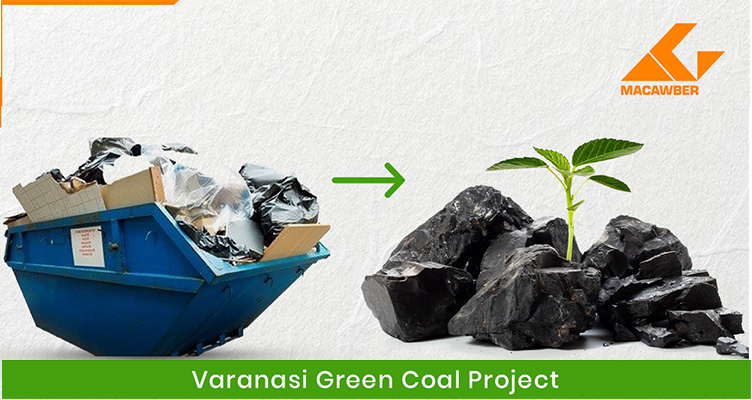The term “green coal” may sound like an oxymoron, but it’s a viable form of renewable energy.
In recent years, green coal has become increasingly popular among businesses and individuals as an alternative energy source. But what is green coal, and how is it different from traditional coal?
In this blog post, we’ll explore the mysterious world of green coal and uncover the facts you need to know.
What is green coal?
Green Coal is a type of eco-friendly coal briquette made from Biowaste or Municipal Solid Waste,. Burning Green Coal decreases sulfur emissions by large while boosting combustion efficiency. Using biochar in the production process qualifies as a renewable energy source, as it replaces fossil fuels. Green coal is an innovative technology that can help reduce the environmental impact of burning coal while still producing usable energy. It is a form of clean coal technology that involves segregation, mixing & Heating processes to convert municipal waste into charcoal.
It is produced by using heating MSW inside rotating cylinders. This process converts a variety of organic materials, such as municipal solid waste, into a high-energy, low-ash, low-sulfur coal substitute.
It is often called ‘clean’ coal, as it produces fewer toxic emissions than ordinary coal. It can substantially reduce air pollution from coal-fired power plants. In addition, green coal can help reduce the cost of electricity generation, as it is much more efficient than traditional coal-fired plants.
The technology behind green coal is still relatively new, but it is gaining traction in the energy industry. Many countries are investing in green coal technologies to reduce reliance on traditional coal-fired power plants. This is because green coal has the potential to provide a cleaner, cheaper, and more reliable source of energy.
Green coal is a promising form of clean coal technology that can reduce the environmental impact of burning coal while still providing usable energy. It is still in its early stages, but it has the potential to revolutionize the energy industry and help reduce the environmental impact of coal burning.
How Green coal is produced?
Green coal is produced by Waste to coal (WTC) facilities using the Heating process. The process begins with the conversion of Raw waste into Refused Drive Fuel (RDF). They are heated into Reactor. During this process, it breaks down the RDF molecules and converts them into liquid fuels and Charcoal. Liquid fuels are used as an energy source to heat the dryer & reactor and Charcoal l is used to produce green coal.
The reaction inside the Reactor is relatively simple and cost-effective. The process does not require any chemical additives or hazardous processes and is much more efficient than traditional coal-burning processes. In addition, green coal is produced from waste materials, which are available in abundance, making it a much more sustainable energy source.
How is green coal different from traditional coal?
Green coal differs from traditional coal in its production and use.
Traditional coal production methods involve coal extraction from mines, which can lead to the destruction of natural habitats and release pollutants such as sulfur and nitrogen oxides, particulate matter, and carbon dioxide (CO2).
In contrast, green coal is produced through processes such as Waste to coal (WTC) which makes it environment-friendly and cost-effective.
Green coal can be used in various applications such as power generation, steel plants, dying industries, cement industry, and industrial use more cleanly and efficiently than traditional coal.
Applications of green coal
Power Generation
In power generation, green coal can be used to generate electricity more cleanly and efficiently than traditional coal-fired power plants.
Industrial use
Green coal can also produce chemicals, fertilizers steel, cement, and other industrial products.
Conclusion
Green coal is a clean and efficient way of utilizing waste resources while minimizing the negative environmental impact. It can be used in various applications such as power generation, steel, cement, and industrial use, making it a valuable addition to the energy mix as we transition to a more sustainable future.
While it may have its challenges, such as cost, the scale of production, and environmental impact, the potential benefits of green coal must be addressed, and further research and development are needed to make it a viable option in the long term.
Frequently Asked Questions (FAQs)
What is green coal?
Green coal, also known as clean coal, is a term used to describe coal produced in a way that is more environmentally friendly than traditional coal production methods.
What are the challenges and limitations of green coal?
One of the main challenges is the cost of production. The equipment and technology required for green coal production are expensive, making it difficult for countries with limited financial resources to adopt this technology.
Is green coal a renewable energy source?
Green coal can be considered a renewable energy source because it is not a fossil fuel, meaning it is a renewable resource. Green coal production methods aim to reduce emissions and pollutants associated with traditional coal mining and use, making it a cleaner and more environmentally friendly option than traditional coal.
 IND
IND VN
VN CN
CN KR
KR JP
JP
